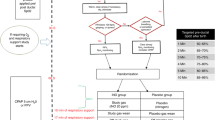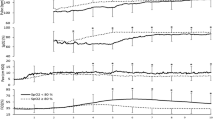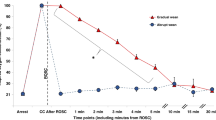Abstract
International guidelines for newborn resuscitation recommend the use of 100% oxygen. However, high concentrations of oxygen after asphyxiation activate reactive oxygen species that may contribute to a number of morbidities. Animal models have been useful in describing their mechanisms, but only large-scale clinical trials can provide evidence that may be used to alter clinical practice. It has been demonstrated that neonates recover faster when resuscitated with room air as opposed to pure oxygen and neonatal mortality rates are improved. Increases in saturation are equal with oxygen and room air resuscitation. Studies of normal oxygen saturation immediately after birth suggest that clinicians may unnecessarily be rushing to high saturations. In the first weeks of life, lower saturation targets in preterm infants reduce retinopathy of prematurity and pulmonary complications and may improve growth. The neonatologist would be well served to think of oxygen as a medication, and use it sparingly.
This is a preview of subscription content, access via your institution
Access options
Subscribe to this journal
Receive 12 print issues and online access
$259.00 per year
only $21.58 per issue
Buy this article
- Purchase on Springer Link
- Instant access to full article PDF
Prices may be subject to local taxes which are calculated during checkout

Similar content being viewed by others
References
Nick Lane. Oxygen: The Molecule That Made the World. Oxford: Oxford University Press; 2003.
Saugstad OD, Aasen AO . Plasma hypoxanthine concentrations in pigs. A prognostic aid in hypoxia. Eur Surg Res 1980;12:123–129.
Saugstad OD, Sanderud J . Circulatory effects of oxygen radicals. Biomed Biochim Acta 1989;48:S20–S24.
World Health Organization. Child Health and Development: Health of the Newborn. Geneva, Switzerland: World Health Organization; 1991.
Kattwinkel J, Niermeyer S, Nadkarni V, et al. An advisory statement from the Pediatric Working Group of the International Liaison Committee on Resuscitation. Pediatrics 1999;103:e56.
Wardman P, Candeias LP . Fenton chemistry: an introduction. Radiat Res 1996;145:523–531.
Poulsen JP, Oyasaeter S, Sanderud J, Rognum TO, Saugstad OD . Hypoxanthine, xanthine, and uric acid concentrations in the cerebrospinal fluid, plasma, and urine of hypoxemic pigs. Pediatr Res 1990;28:477–481.
Almaas R, Sundar TB, Rootwelt T, Oyasaeter S, Saugstad OD . Plasma hypoxanthine reacts more abruptly to changes in oxygenation than base deficit and uric acid in newborn piglets. J Perinat Med 1997;25:353–360.
Rootwelt T, Odden JP, Hall C, Ganes T, Saugstad OD . Cerebral blood flow and evoked potentials during reoxygenation with 21 or 100% O2 in newborn pigs. J Appl Physiol 1993;75:2054–2060.
Rootwelt T, Loberg EM, Moen A, Oyasaeter S, Saugstad OD . Hypoxemia and reoxygenation with 21% or 100% oxygen in newborn pigs: changes in blood pressure, base deficit, and hypoxanthine and brain morphology. Pediatr Res 1992;32:107–113.
Saugstad OD . The role of oxygen in neonatal resuscitation. Clin Perinatol 2004;31:431–443.
Kutzsche S, Ilves P, Kirkeby OJ, Saugstad OD . Hydrogen peroxide production in leukocytes during cerebral hypoxia and reoxygenation with 100% or 21% oxygen in newborn piglets. Pediatr Res 2001;49:834–842.
Kondo M, Itoh S, Isobe K, et al. Chemiluminescence because of the production of reactive oxygen species in the lungs of newborn piglets during resuscitation periods after asphyxiation load. Pediatr Res 2000;47:524–527.
Saugstad OD, Rootwelt T, Aalen O . Resuscitation of asphyxiated newborn infants with room air or oxygen: an international controlled trial: the Resair 2 study. Pediatrics 1998;102:e1.
Ramji S, Rasaily R, Mishra PK, et al. Resuscitation of asphyxiated newborns with room air or 100% oxygen at birth: a multicentric clinical trial. Indian Pediatr 2003;40:510–517.
Saugstad OD, Ramji S, Vento M . Resuscitation of depressed newborn infants with ambient air or pure oxygen: a meta-analysis. Biol Neonate 2005;87:27–34.
Rao R, Ramji S . Pulse oximetry in asphyxiated newborns in the delivery room. Indian Pediatr 2001;38:762–766.
Tin W, Milligan DW, Pennefather P, Hey E . Pulse oximetry, severe retinopathy, and outcome at one year in babies of less than 28 weeks gestation. Arch Dis Child Fetal Neonatal Ed 2001;84:F106–F110.
Anderson CG, Benitz WE, Madan A . Retinopathy of prematurity and pulse oximetry: a national survey of recent practices. J Perinatol 2004;24:164–168.
Askie LM, Henderson-Smart DJ, Irwig L, Simpson JM . Oxygen-saturation targets and outcomes in extremely preterm infants. N Engl J Med 2003;349:959–967.
Chow LC, Wright KW, Sola A . Can changes in clinical practice decrease the incidence of severe retinopathy of prematurity in very low birth weight infants? Pediatrics 2003;111:339–345.
Vento M, Asensi M, Sastre J, Garcia-Sala F, Pallardo FV, Vina J . Resuscitation with room air instead of 100% oxygen prevents oxidative stress in moderately asphyxiated term neonates. Pediatrics 2001;107:642–647.
Temesvari P, Karg E, Bodi I, et al. Impaired early neurologic outcome in newborn piglets reoxygenated with 100% oxygen compared with room air after pneumothorax-induced asphyxia. Pediatr Res 2001;49:812–819.
Munkeby BH, Borke WB, Bjornland K, et al. Resuscitation with 100% O2 increases cerebral injury in hypoxemic piglets. Pediatr Res 2004;56:783–790.
Borke WB, Munkeby BH, Halvorsen B, et al. Increased myocardial matrix metalloproteinases in hypoxic newborn pigs during resuscitation: effects of oxygen and carbon dioxide. Eur J Clin Invest 2004;34:459–466.
Tin W . Optimal oxygen saturation for preterm babies. Biol Neonat 2004;85:319–325.
Author information
Authors and Affiliations
Additional information
Proprietary interest/disclosure: None.
Rights and permissions
About this article
Cite this article
Saugstad, O. Oxygen for Newborns: How Much is Too Much?. J Perinatol 25 (Suppl 2), S45–S49 (2005). https://doi.org/10.1038/sj.jp.7211321
Published:
Issue Date:
DOI: https://doi.org/10.1038/sj.jp.7211321
This article is cited by
-
Tyrosine Phosphorylation of Apoptotic Proteins During Hyperoxia in Mitochondria of the Cerebral Cortex of Newborn Piglets
Neurochemical Research (2010)
-
Incidence and risk factors for retinopathy of prematurity in very low and in extremely low birth weight infants in a unit-based approach in southern Brazil
Eye (2009)
-
D-Penicillamine administration and the incidence of retinopathy of prematurity
Journal of Perinatology (2007)
-
A pilot trial testing the feasibility of administering D-penicillamine to extremely low birth weight neonates
Journal of Perinatology (2006)
-
Oxygen and retinopathy of prematurity
Journal of Perinatology (2006)



